descriptive essay
- 格式:doc
- 大小:155.64 KB
- 文档页数:21
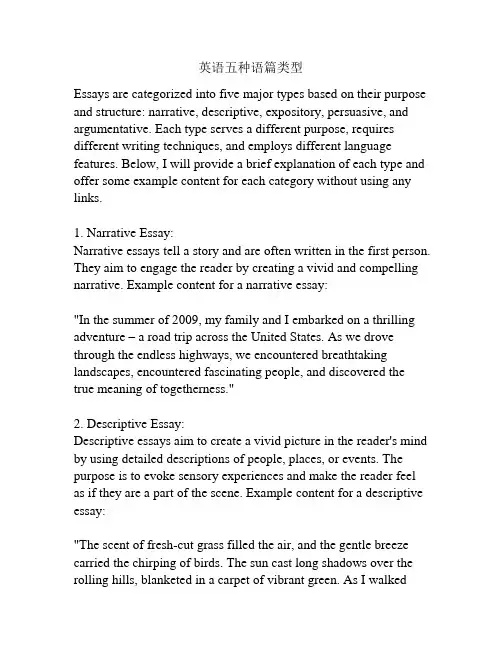
英语五种语篇类型Essays are categorized into five major types based on their purpose and structure: narrative, descriptive, expository, persuasive, and argumentative. Each type serves a different purpose, requires different writing techniques, and employs different language features. Below, I will provide a brief explanation of each type and offer some example content for each category without using any links.1. Narrative Essay:Narrative essays tell a story and are often written in the first person. They aim to engage the reader by creating a vivid and compelling narrative. Example content for a narrative essay:"In the summer of 2009, my family and I embarked on a thrilling adventure – a road trip across the United States. As we drove through the endless highways, we encountered breathtaking landscapes, encountered fascinating people, and discovered the true meaning of togetherness."2. Descriptive Essay:Descriptive essays aim to create a vivid picture in the reader's mind by using detailed descriptions of people, places, or events. The purpose is to evoke sensory experiences and make the reader feel as if they are a part of the scene. Example content for a descriptive essay:"The scent of fresh-cut grass filled the air, and the gentle breeze carried the chirping of birds. The sun cast long shadows over the rolling hills, blanketed in a carpet of vibrant green. As I walkedthrough the field, the soft blades of grass tickled my bare feet, and the warm sunlight bathed my face."3. Expository Essay:Expository essays present information, provide explanation, and explore a topic without expressing personal opinions. This type of essay is commonly used in academic writing and aims to educate the reader on a specific subject. Example content for an expository essay:"The Industrial Revolution was a period of rapid technological advancements that transformed society. Through the development of steam power, the invention of factories, and the mechanization of industries, the world underwent a dramatic shift from agrarian to industrialized economies."4. Persuasive Essay:Persuasive essays aim to convince the reader to adopt a certain viewpoint or take a specific action. These essays rely on logical reasoning, evidence, and emotional appeals to convince the reader. Example content for a persuasive essay:"Eating a plant-based diet has numerous benefits, not only for our own health but also for the environment. Research has shown that a plant-based diet can lower the risk of chronic diseases, reduce greenhouse gas emissions, and alleviate animal suffering."5. Argumentative Essay:Argumentative essays present a logical argument and provide evidence to support a specific claim or position. They addresscounterarguments and aim to convince the reader that a particular viewpoint is more valid than others. Example content for an argumentative essay:"The legalization of marijuana has been a subject of intense debate in recent years. Proponents argue that it can generate tax revenue, alleviate medical conditions, and reduce criminal activity associated with it. However, opponents claim that legalization may lead to increased drug abuse and jeopardize public safety."。
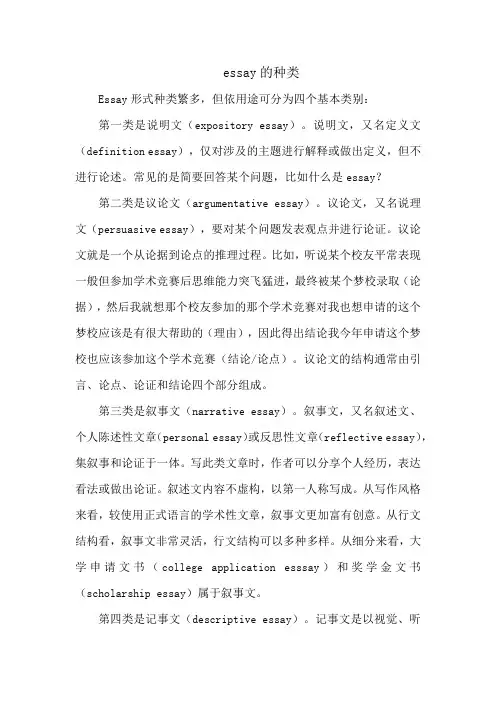
essay的种类Essay形式种类繁多,但依用途可分为四个基本类别:第一类是说明文(expository essay)。
说明文,又名定义文(definition essay),仅对涉及的主题进行解释或做出定义,但不进行论述。
常见的是简要回答某个问题,比如什么是essay?第二类是议论文(argumentative essay)。
议论文,又名说理文(persuasive essay),要对某个问题发表观点并进行论证。
议论文就是一个从论据到论点的推理过程。
比如,听说某个校友平常表现一般但参加学术竞赛后思维能力突飞猛进,最终被某个梦校录取(论据),然后我就想那个校友参加的那个学术竞赛对我也想申请的这个梦校应该是有很大帮助的(理由),因此得出结论我今年申请这个梦校也应该参加这个学术竞赛(结论/论点)。
议论文的结构通常由引言、论点、论证和结论四个部分组成。
第三类是叙事文(narrative essay)。
叙事文,又名叙述文、个人陈述性文章(personal essay)或反思性文章(reflective essay),集叙事和论证于一体。
写此类文章时,作者可以分享个人经历,表达看法或做出论证。
叙述文内容不虚构,以第一人称写成。
从写作风格来看,较使用正式语言的学术性文章,叙事文更加富有创意。
从行文结构看,叙事文非常灵活,行文结构可以多种多样。
从细分来看,大学申请文书(college application esssay)和奖学金文书(scholarship essay)属于叙事文。
第四类是记事文(descriptive essay)。
记事文是以视觉、听觉、嗅觉、味觉和触觉等感觉器官生动地把接触到的人、地或物记述下来的文章。
与叙事文相比,记事文的内容范围更窄。
记事文只讲求记,而叙事文不仅要记而且要议,即夹叙夹议。
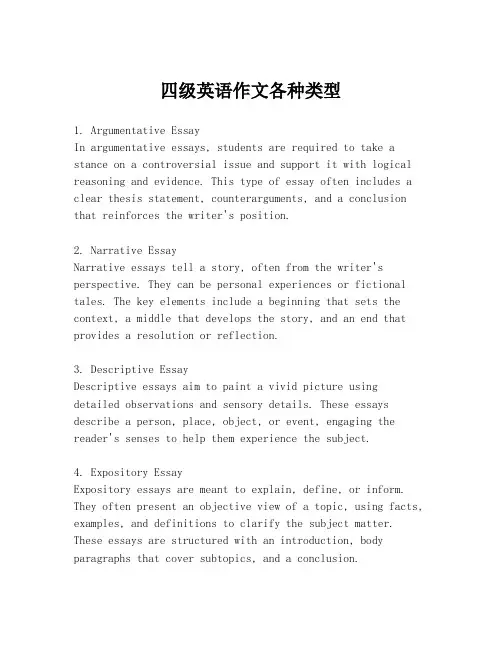
四级英语作文各种类型1. Argumentative EssayIn argumentative essays, students are required to take a stance on a controversial issue and support it with logical reasoning and evidence. This type of essay often includes a clear thesis statement, counterarguments, and a conclusion that reinforces the writer's position.2. Narrative EssayNarrative essays tell a story, often from the writer's perspective. They can be personal experiences or fictional tales. The key elements include a beginning that sets the context, a middle that develops the story, and an end that provides a resolution or reflection.3. Descriptive EssayDescriptive essays aim to paint a vivid picture usingdetailed observations and sensory details. These essays describe a person, place, object, or event, engaging the reader's senses to help them experience the subject.4. Expository EssayExpository essays are meant to explain, define, or inform. They often present an objective view of a topic, using facts, examples, and definitions to clarify the subject matter. These essays are structured with an introduction, body paragraphs that cover subtopics, and a conclusion.5. Persuasive EssayPersuasive essays are designed to convince the reader to adopt a certain point of view or take a specific action. They use persuasive techniques such as emotional appeals, logical reasoning, and credibility to sway the reader's opinion.6. Compare and Contrast EssayIn this type of essay, the writer examines the similarities and differences between two or more subjects. It often starts with an introduction that outlines the subjects, followed by body paragraphs that discuss points of comparison and contrast, and a conclusion that summarizes the findings.7. Cause and Effect EssayCause and effect essays explore the reasons behind an event or the outcomes that result from it. These essays typically have an introduction that presents the event, body paragraphs that discuss the causes and effects, and a conclusion that may suggest implications or solutions.8. Process Analysis EssayProcess analysis essays explain how something works or how to perform a task. They break down a process into steps and may also include the reasoning behind each step. These essays are often structured in chronological order.9. Classification EssayClassification essays organize things into categories based on certain characteristics. The writer defines the criteria for classification and then groups items accordingly. This type of essay often has an introduction that states theclassification scheme, body paragraphs that describe each category, and a conclusion that summarizes the classification.10. Definition EssayDefinition essays aim to clarify the meaning of a term or concept. They often involve providing a definition, exploring the nuances of the term, and using examples to illustrate the definition. These essays are particularly useful for complexor abstract concepts.Each type of essay has its own purpose and structure, and mastering them is crucial for success in the CET-4 writing section. Practice writing essays of various types to improve your skills and prepare for the exam.。

英语作文的类型有多少个英语作文可以根据不同的标准进行分类,以下是一些常见的英语作文类型:1. Narrative Essays(叙述性作文):叙述性作文通常讲述一个故事,可以是个人经历、历史事件或虚构的故事。
这种类型的作文强调情节的发展和人物的塑造。
2. Descriptive Essays(描述性作文):描述性作文旨在通过详细的描述来描绘一个场景、人物、物体或事件,让读者能够在心中形成清晰的画面。
3. Expository Essays(说明性作文):说明性作文用于解释一个概念、过程或原因。
这种类型的作文通常包括定义、分类、比较和对比等。
4. Argumentative Essays(议论性作文):议论性作文是为了说服读者接受作者的观点。
它通常包括论点、证据和反驳。
5. Persuasive Essays(说服性作文):说服性作文与议论性作文类似,但更侧重于说服读者采取特定的行动或改变观点。
6. Comparative Essays(比较性作文):比较性作文着重于分析两个或多个主题的相似之处和不同之处。
7. Process Analysis Essays(过程分析作文):过程分析作文解释如何完成一个特定的任务或过程,通常按照时间顺序或逻辑顺序排列。
8. Cause and Effect Essays(因果关系作文):因果关系作文探讨事件的原因和结果,帮助读者理解不同事件之间的联系。
9. Classification Essays(分类作文):分类作文将事物按照共同特征分组,并对每个类别进行描述。
10. Definition Essays(定义作文):定义作文旨在解释一个词或概念的含义,通常通过例子、比较或其他方法来阐述。
11. Reflective Essays(反思性作文):反思性作文是作者对个人经历、阅读或其他事件的思考和反省。
12. Illustrative Essays(例证性作文):例证性作文通过具体的例子来支持一个观点或主题。
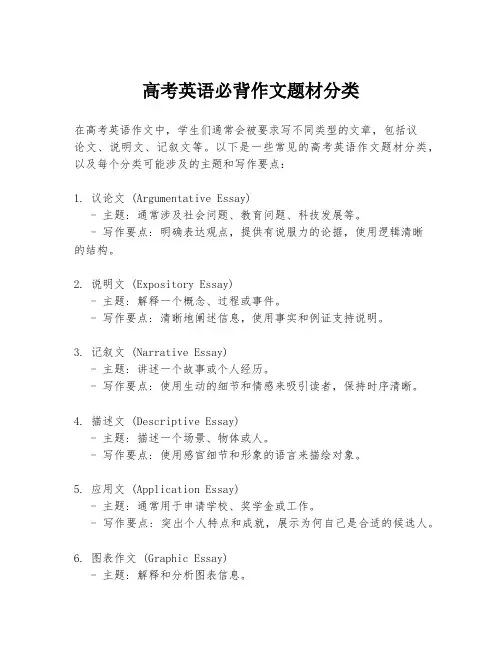
高考英语必背作文题材分类在高考英语作文中,学生们通常会被要求写不同类型的文章,包括议论文、说明文、记叙文等。
以下是一些常见的高考英语作文题材分类,以及每个分类可能涉及的主题和写作要点:1. 议论文 (Argumentative Essay)- 主题: 通常涉及社会问题、教育问题、科技发展等。
- 写作要点: 明确表达观点,提供有说服力的论据,使用逻辑清晰的结构。
2. 说明文 (Expository Essay)- 主题: 解释一个概念、过程或事件。
- 写作要点: 清晰地阐述信息,使用事实和例证支持说明。
3. 记叙文 (Narrative Essay)- 主题: 讲述一个故事或个人经历。
- 写作要点: 使用生动的细节和情感来吸引读者,保持时序清晰。
4. 描述文 (Descriptive Essay)- 主题: 描述一个场景、物体或人。
- 写作要点: 使用感官细节和形象的语言来描绘对象。
5. 应用文 (Application Essay)- 主题: 通常用于申请学校、奖学金或工作。
- 写作要点: 突出个人特点和成就,展示为何自己是合适的候选人。
6. 图表作文 (Graphic Essay)- 主题: 解释和分析图表信息。
- 写作要点: 准确解读数据,使用比较和对比来展示趋势。
7. 信件 (Letter Writing)- 主题: 正式或非正式的信件写作。
- 写作要点: 遵循信件格式,清晰表达目的,保持礼貌和专业。
8. 故事续写 (Story Continuation)- 主题: 基于给定的故事开头继续写作。
- 写作要点: 保持故事的连贯性,创造性地发展情节。
9. 观点对比 (Point of View Comparison)- 主题: 对比不同人或群体的观点。
- 写作要点: 展示不同视角,分析其差异和原因。
10. 问题解决 (Problem-Solution Essay)- 主题: 提出一个问题并提供解决方案。
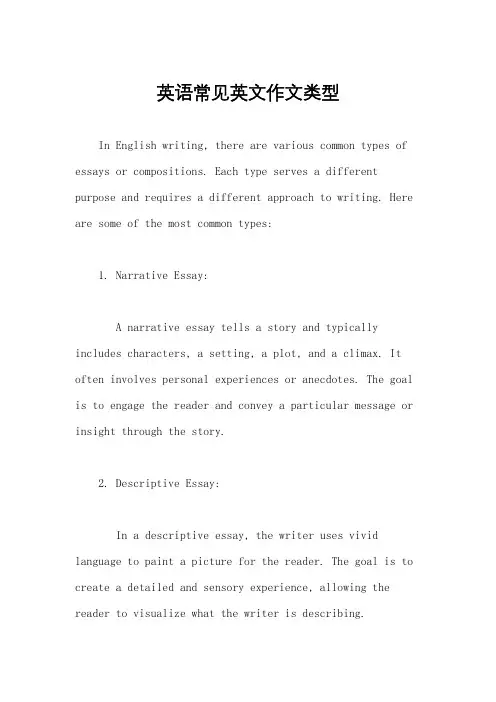
英语常见英文作文类型In English writing, there are various common types of essays or compositions. Each type serves a different purpose and requires a different approach to writing. Here are some of the most common types:1. Narrative Essay:A narrative essay tells a story and typically includes characters, a setting, a plot, and a climax. It often involves personal experiences or anecdotes. The goal is to engage the reader and convey a particular message or insight through the story.2. Descriptive Essay:In a descriptive essay, the writer uses vivid language to paint a picture for the reader. The goal is to create a detailed and sensory experience, allowing the reader to visualize what the writer is describing.3. Expository Essay:An expository essay presents balanced and factual information on a topic. It explains, defines, or clarifies a concept or idea. This type of essay often includes analysis, comparison, and contrast.4. Persuasive Essay:A persuasive essay aims to convince the reader to adopt a particular point of view or take a specific action. It presents arguments and evidence to support the writer's position, often addressing counterarguments as well.5. Argumentative Essay:Similar to a persuasive essay, an argumentative essay presents a claim or thesis statement and supports it with evidence. However, in an argumentative essay, the writer acknowledges and refutes opposing viewpoints more explicitly.6. Analytical Essay:An analytical essay examines a piece of literature, a film, a historical event, or another subject in detail. It breaks down the subject into its component parts and evaluates how they contribute to the overall meaning or significance.7. Compare and Contrast Essay:A compare and contrast essay explores thesimilarities and differences between two or more subjects. It may focus on various aspects such as themes, characters, events, or theories, and it often leads to insights about the subjects being compared.8. Cause and Effect Essay:A cause and effect essay explores the relationship between events or phenomena, examining how one leads to another or how multiple factors contribute to a particularoutcome. It may focus on immediate or long-term effects.9. Process Essay:A process essay explains how to do something or how something works. It provides step-by-step instructions or descriptions of a process, aiming to educate the reader on the topic.10. Reflective Essay:A reflective essay encourages introspection andself-examination. It typically involves personal thoughts, experiences, and insights, allowing the writer to reflect on a specific topic or event and consider its significance.These are just some of the common types of essays in English writing. Each type requires different approaches to organization, tone, and style, but they all serve the purpose of communicating ideas effectively to the reader.。
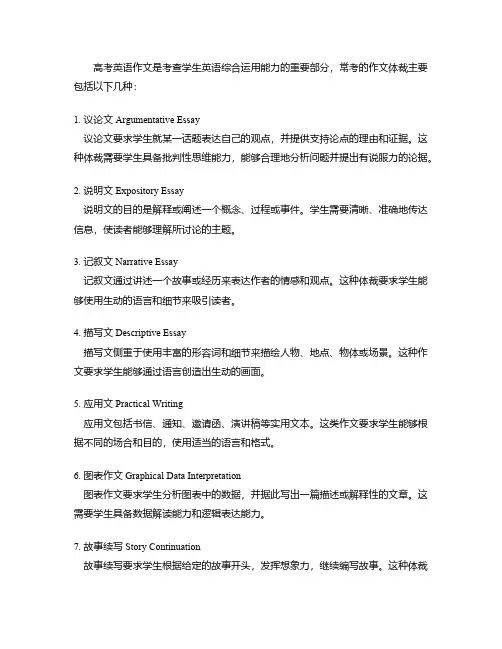
高考英语作文是考查学生英语综合运用能力的重要部分,常考的作文体裁主要包括以下几种:1. 议论文Argumentative Essay议论文要求学生就某一话题表达自己的观点,并提供支持论点的理由和证据。
这种体裁需要学生具备批判性思维能力,能够合理地分析问题并提出有说服力的论据。
2. 说明文Expository Essay说明文的目的是解释或阐述一个概念、过程或事件。
学生需要清晰、准确地传达信息,使读者能够理解所讨论的主题。
3. 记叙文Narrative Essay记叙文通过讲述一个故事或经历来表达作者的情感和观点。
这种体裁要求学生能够使用生动的语言和细节来吸引读者。
4. 描写文Descriptive Essay描写文侧重于使用丰富的形容词和细节来描绘人物、地点、物体或场景。
这种作文要求学生能够通过语言创造出生动的画面。
5. 应用文Practical Writing应用文包括书信、通知、邀请函、演讲稿等实用文本。
这类作文要求学生能够根据不同的场合和目的,使用适当的语言和格式。
6. 图表作文Graphical Data Interpretation图表作文要求学生分析图表中的数据,并据此写出一篇描述或解释性的文章。
这需要学生具备数据解读能力和逻辑表达能力。
7. 故事续写Story Continuation故事续写要求学生根据给定的故事开头,发挥想象力,继续编写故事。
这种体裁考查学生的创造力和语言组织能力。
8. 看图写话Picture Caption Writing看图写话要求学生根据一幅或几幅图画,写出相应的描述或故事。
这种作文考查学生对视觉信息的理解和表达能力。
9. 摘要写作Summary Writing摘要写作要求学生阅读一篇文章或文本,并将其主要内容以简短的形式总结出来。
这需要学生具备提炼关键信息和概括的能力。
10. 观点对比Comparative Argumentation观点对比要求学生比较和对比不同的观点或论点,并在此基础上形成自己的见解。
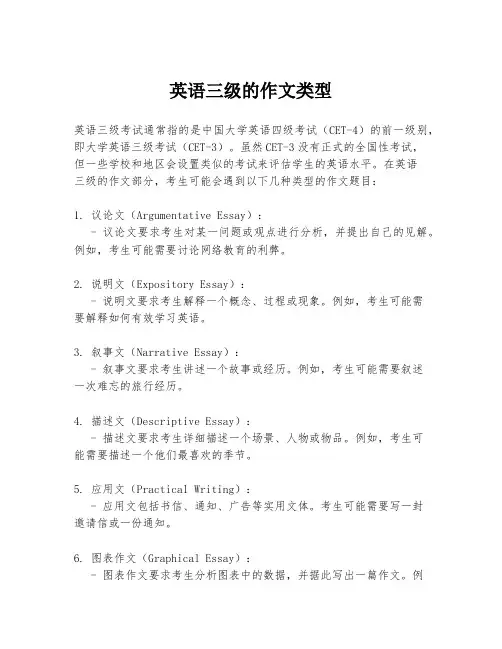
英语三级的作文类型英语三级考试通常指的是中国大学英语四级考试(CET-4)的前一级别,即大学英语三级考试(CET-3)。
虽然CET-3没有正式的全国性考试,但一些学校和地区会设置类似的考试来评估学生的英语水平。
在英语三级的作文部分,考生可能会遇到以下几种类型的作文题目:1. 议论文(Argumentative Essay):- 议论文要求考生对某一问题或观点进行分析,并提出自己的见解。
例如,考生可能需要讨论网络教育的利弊。
2. 说明文(Expository Essay):- 说明文要求考生解释一个概念、过程或现象。
例如,考生可能需要解释如何有效学习英语。
3. 叙事文(Narrative Essay):- 叙事文要求考生讲述一个故事或经历。
例如,考生可能需要叙述一次难忘的旅行经历。
4. 描述文(Descriptive Essay):- 描述文要求考生详细描述一个场景、人物或物品。
例如,考生可能需要描述一个他们最喜欢的季节。
5. 应用文(Practical Writing):- 应用文包括书信、通知、广告等实用文体。
考生可能需要写一封邀请信或一份通知。
6. 图表作文(Graphical Essay):- 图表作文要求考生分析图表中的数据,并据此写出一篇作文。
例如,考生可能需要根据一张饼状图来讨论不同人群的阅读习惯。
7. 故事续写(Story Continuation):- 故事续写要求考生根据给定的故事开头,继续编写故事。
例如,考生可能需要续写一个关于意外发现的故事。
每种类型的作文都有其特定的结构和写作技巧。
考生在准备考试时,应该熟悉这些类型,并练习各种写作技巧。
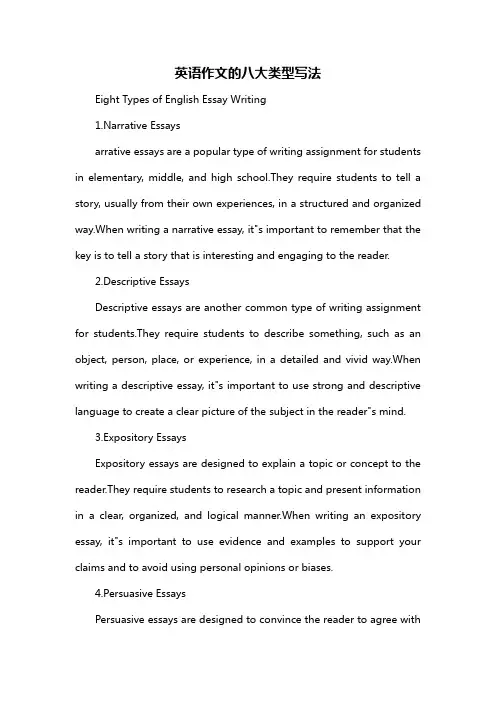
英语作文的八大类型写法Eight Types of English Essay Writing1.Narrative Essaysarrative essays are a popular type of writing assignment for students in elementary, middle, and high school.They require students to tell a story, usually from their own experiences, in a structured and organized way.When writing a narrative essay, it"s important to remember that the key is to tell a story that is interesting and engaging to the reader.2.Descriptive EssaysDescriptive essays are another common type of writing assignment for students.They require students to describe something, such as an object, person, place, or experience, in a detailed and vivid way.When writing a descriptive essay, it"s important to use strong and descriptive language to create a clear picture of the subject in the reader"s mind.3.Expository EssaysExpository essays are designed to explain a topic or concept to the reader.They require students to research a topic and present information in a clear, organized, and logical manner.When writing an expository essay, it"s important to use evidence and examples to support your claims and to avoid using personal opinions or biases.4.Persuasive EssaysPersuasive essays are designed to convince the reader to agree witha particular point of view or take a specific action.They require students to research a topic, present their arguments, and use evidence and persuasive techniques to convince the reader of their viewpoint.When writing a persuasive essay, it"s important to present a balanced argument and to address any potential counterarguments.pare and Contrast EssaysCompare and contrast essays require students to compare two or more items, ideas, or concepts and to point out their similarities and differences.When writing a compare and contrast essay, it"s important to clearly explain the purpose of the comparison and to use clear and organized writing to make the comparison easy to follow.6.Process Analysis EssaysProcess analysis essays require students to describe a process or how something is made or done.They require students to break down the process into steps and to explain each step in a clear and detailed way.When writing a process analysis essay, it"s important to use clear and concise language and to include any necessary explanations or definitions.7.Cause and Effect EssaysCause and effect essays require students to explain the causes and effects of a particular event, situation, or decision.When writing a cause and effect essay, it"s important to clearly identify the cause and effectrelationships and to use evidence and examples to support your claims.8.Review and Reflection EssaysReview and reflection essays require students to evaluate and reflect on their own writing or on a piece of literature, movie, or other media.When writing a review and reflection essay, it"s important to provide a clear and honest evaluation of the subject and to reflect on what you have learned or how you have been changed by the experience.In conclusion, there are many different types of essays that students may be asked to write in their academic careers.Each type of essay has its own unique structure and purpose, and it"s important for students to understand the requirements and expectations of each type before they begin to write.With practice and experience, students can become skilled and confident writers in any essay genre.。
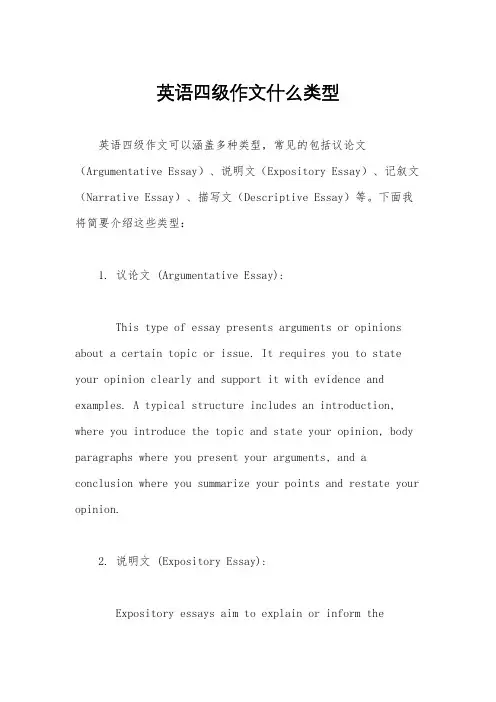
英语四级作文什么类型英语四级作文可以涵盖多种类型,常见的包括议论文(Argumentative Essay)、说明文(Expository Essay)、记叙文(Narrative Essay)、描写文(Descriptive Essay)等。
下面我将简要介绍这些类型:1. 议论文 (Argumentative Essay):This type of essay presents arguments or opinions about a certain topic or issue. It requires you to state your opinion clearly and support it with evidence and examples. A typical structure includes an introduction, where you introduce the topic and state your opinion, body paragraphs where you present your arguments, and a conclusion where you summarize your points and restate your opinion.2. 说明文 (Expository Essay):Expository essays aim to explain or inform thereader about a particular topic. They require clear and concise writing, and often follow a logical sequence or order of events. You may need to define terms, describe processes, or analyze information. The structure usually consists of an introduction, body paragraphs focusing on different aspects of the topic, and a conclusion summarizing the main points.3. 记叙文 (Narrative Essay):Narrative essays tell a story or recount an event from a personal perspective. They often include vivid descriptions, sensory details, and emotional elements to engage the reader. You should establish a clear plot, characters, setting, and conflict. The essay should have a beginning, middle, and end, and may include dialogue or reflection.4. 描写文 (Descriptive Essay):Descriptive essays focus on describing a person, place, object, or event in detail. They aim to create avivid picture in the reader's mind using sensory language and imagery. You should use descriptive adjectives and adverbs to convey your impressions effectively. The essay should have a clear organizational structure, such as spatial or chronological order.以上是英语四级作文常见的类型,选择适合你题目的类型,并确保在文章中清晰表达你的想法,并提供充分的论据和例子来支持你的观点。

英语四大基本文体
英语中的四大基本文体是记叙文(narrative essay),说明文(expository essay),议论文(argumentative essay)和说明文(descriptive essay)。
记叙文是通过叙述事情的经过、人物的行为和情节的发展来传递信息或表达感受的文体。
它通常由一系列事件或故事组成,包含时间、地点、人物、情节等要素。
说明文是用来解释、阐述或传递信息的文体。
它可以用来描述一个概念、一个过程、一个观点或一个现象。
说明文通常包含事实、数据、例子和逻辑推理等来支持作者的观点或说明信息。
议论文是用来表达观点、辩论和说服读者的文体。
议论文通常包含一个明确的观点(也称为论点)和相关的证据、论证和解释来支持这个观点。
它可以通过逻辑、权威性的引用或对比等方法来增强说服力。
说明文是用来描绘事物的特征、外观和感官体验的文体。
它通过详细和生动的描述来让读者感知事物的各个方面。
说明文可以通过用词的精确选择、比喻、比较等手法来传达作者对事物的感受或呈现细节。
十四类英语作文模板英文回答:1. Descriptive Essay:Describe a person, place, thing, or event in vivid detail.Use sensory language to create a strong impression on the reader.Organize your description logically, using spatial or chronological order.2. Narrative Essay:Tell a story that has a clear beginning, middle, and end.Use vivid language and dialogue to bring the storyto life.Maintain a consistent point of view and use appropriate transitions.3. Expository Essay:Explain a concept or idea in a clear and organized manner.Use evidence and examples to support your claims.Organize your essay using a logical structure, such as cause and effect or compare and contrast.4. Persuasive Essay:Argue for or against a particular point of view.Use facts, evidence, and logical reasoning to support your argument.Organize your essay using a claim, reasons, and evidence structure.5. Reflective Essay:Explore your thoughts and feelings about a personal experience or issue.Use introspective language to share your insights and growth.Organize your essay using a chronological or thematic structure.6. Compare and Contrast Essay:Examine the similarities and differences between two or more subjects.Use a clear and organized structure, such as block or point-by-point.Provide specific examples and analysis to support your comparisons.7. Problem-Solution Essay:Identify a problem and propose a solution.Use logical reasoning and evidence to support your solution.Organize your essay using a clear problem-solution structure.8. Cause and Effect Essay:Explore the causes and effects of a particular event or issue.Use a logical structure, such as chronological or causal chain.Provide specific examples and evidence to supportyour analysis.9. Argumentative Essay:Present a reasoned argument for or against a particular position.Use evidence, logical reasoning, and persuasive language to support your argument.Organize your essay using a clear claim, reasons, and evidence structure.10. Research Essay:Investigate a specific topic using credible sources.Organize your essay logically, using a clear introduction, body paragraphs, and conclusion.Cite your sources accurately using a recognized citation style.11. Analytical Essay:Examine and interpret a literary text, film, or other work of art.Use close reading and critical analysis to support your insights.Organize your essay using a clear thesis statement and supporting paragraphs.12. Evaluation Essay:Critique a work of art, performance, or product.Use specific criteria to assess the work's strengths and weaknesses.Organize your essay using a clear introduction, body paragraphs, and conclusion.13. Proposal Essay:Propose a solution to a problem or issue.Use logical reasoning, evidence, and persuasive language to support your proposal.Organize your essay using a clear introduction, body paragraphs, and conclusion.14. Informative Essay:Convey information about a specific topic in a clear and organized manner.Use credible sources and objective language to present the information.Organize your essay using a logical structure, such as chronological or topical.中文回答:1. 描述性文章:详细描述一个人、地方、事物或事件。
英语作文文章类型
1. 议论文(Argumentative essay):阐述作者观点,探讨论题
并提供相关证据和逻辑推理来支持自己的观点。
2. 描述文(Descriptive essay):描述一件事物或场景的外观、特点、感受等细节,让读者产生视觉或感官上的感受。
3. 记叙文(Narrative essay):叙述一件真实的或虚构的故事,通过故事情节、环境、人物塑造、冲突发展等方式来表达思想和情感。
4. 说明文(Explanatory essay):解释或阐述某个现象、原理、事实或规律,以及原因、过程、影响等方面的详细解释。
5. 比较文(Comparison essay):对两种或以上的事物进行比较,以便于读者全面、深入地了解它们的不同之处,从而得出结论。
6. 批判文(Critique essay):批评或评论某个作品、人物或事情,分析其优点、缺点、局限性等,提出自己的看法和建议。
7. 综合性文章(Mixed-type essay):将以上不同类型文章的
特点融合起来,综合表达作者的思想、情感和观点。
中考英语作文不同类型范文Sure, here are a few different types of English compositions for the middle school English exam:1. Narrative EssayEnglish:Last summer, my family and I went on a trip to the beach. It was a very hot day and the sun was shining brightly in the sky. We played in the water, built sandcastles, and had a picnic on the shore. In the evening, we watched the sunset and it was the most beautiful sight I had ever seen.Chinese:去年夏天,我和我的家人去了海滩度假。
那是一个炎热的日子,太阳高挂在天空中。
我们在水里玩耍,搭建沙堡,在岸边野餐。
傍晚时分,我们看着夕阳西下,那是我见过最美丽的景色。
2. Descriptive EssayEnglish:The Great Wall of China is one of the most magnificent man-made structures in the world. It stretches over 13,000 miles and was built over 2,000 years ago to protect the Chinese empire from invasions. The wall is made of stone, brick, and wood and is a symbol of China's rich history and culture.Chinese:中国长城是世界上最宏伟的人造结构之一。
descriptive essay特点
嘿,咱来说说 descriptive essay 啊!这玩意儿就像是一幅生动的画,能把你看到的、听到的、感觉到的都给细细描绘出来。
比如说,你看到了一片美丽的花海,那 descriptive essay 就能把那花海的各种颜色、各种姿态,甚至是那花香都给你写得活灵活现,就好像你真的置身其中一样!
它不是干巴巴地陈述事实,而是带着感情的呀!就像你跟朋友兴奋地讲述你遇到的一件超棒的事情,眉飞色舞的,把那种兴奋劲儿都传达出来。
比如你描述一场刺激的比赛,那紧张的气氛、选手们的表情动作,都能让读者感受到你的激动。
再打个比方,它就像一部精彩的电影,有特写镜头,有全景画面。
可以聚焦在一个小细节上,把它刻画得无比细腻,也能把整个大场景都展现得淋漓尽致。
比如描述一个古老的建筑,那墙壁上的斑驳、屋顶的形状,还有周围的环境,都能一一呈现。
写 descriptive essay 就像是在创造一个小世界,你就是这个世界的主宰,你想让读者看到什么、感受到什么,全由你决定!你可以把最细微的感受都写进去,让读者跟着你的笔触去体验。
它可不像那些死板的文章,它充满了趣味和魅力!能让读者读着读着就沉浸其中,忘记了周围的一切。
这就是 descriptive essay 的独特之处啊,它能让文字变得有魔力!
我觉得 descriptive essay 就是一种超级棒的表达形式,能把我们生活中的点点滴滴都描绘得无比精彩,让那些瞬间都永远地留在文字里,让后人也能感受到我们曾经的感受。
它让我们的世界变得更加丰富多彩,不是吗?。
英语作文哪个类型好写在英语作文中,选择一个容易写作的类型往往取决于个人的兴趣、写作技巧以及对特定主题的熟悉程度。
以下是几种常见的英语作文类型,以及它们各自的特点:1. 叙述文(Narrative Essay):- 描述个人经历或故事。
- 容易写作,因为可以基于真实事件。
- 需要清晰的开头、发展和结尾。
2. 描述文(Descriptive Essay):- 描述一个地点、人、物或事件。
- 通过感官细节吸引读者。
- 需要丰富的词汇和创造性的表达。
3. 议论文(Argumentative Essay):- 提出观点并提供支持论据。
- 需要逻辑性和批判性思维。
- 适合喜欢辩论和分析的写作者。
4. 说明文(Expository Essay):- 解释一个概念或过程。
- 需要清晰的结构和条理。
- 适合喜欢解释和教育他人的写作者。
5. 反思文(Reflective Essay):- 对个人经历进行反思和分析。
- 需要深度的自我探索和内省。
- 适合喜欢自我反思和写作的写作者。
6. 比较和对比文(Compare and Contrast Essay):- 对两个或多个对象进行比较和对比。
- 需要分析和对比的能力。
- 适合喜欢分析和比较事物的写作者。
选择哪种类型好写,很大程度上取决于你个人的兴趣和强项。
如果你喜欢讲故事,叙述文可能更适合你;如果你善于观察和描述,描述文可能更合适;如果你喜欢分析和辩论,议论文可能是你的菜;如果你喜欢解释和教育,说明文可能更合适;如果你喜欢深入思考和自我探索,反思文可能更符合你的风格;如果你喜欢分析和比较,比较和对比文可能更适合你。
记住,无论选择哪种类型,都要确保你的作文有清晰的结构,逻辑性强,并且语言流畅。
How to Write a Descriptive EssayWriting a descriptive essayA descriptive essay is a type of essay that provides a vivid description of a person, place, scene, object, experience, memory, etc. in the way the reader can easily get its physical realization. More than many other types of essays, descriptive essays strive to create a deeply involved and vivid experience for the reader. Great descriptive essays achieve this affect not through facts and statistics but by using detailed observations and descriptions.What do you want to describe?As you get started on your descriptive essay, it's important for you to identify exactly what you want to describe. Often, a descriptive essay will focus on portraying one of the following:● a person● a place● a memory●an experience●an objectUltimately, whatever you can perceive or experience can be the focus of your descriptive writing.Why are you writing your descriptive essay?It's a great creative exercise to sit down and simply describe what you observe. However, when writing a descriptive essay, you often have a particular reason for writing your description. Getting in touch with this reason can help you focus your description and imbue your language with a particular perspective or emotion. Example: Imagine that you want to write a descriptive essay about your grandfather. You've chosen to write about your grandfather's physical appearance and the way that he interacts with people. However, rather than providing a general description of these aspects, you want to convey your admiration for his strength and kindness. This is your reason for writing the descriptive essay. To achieve this, you might focus one of your paragraphs on describing the roughness of his hands, roughness resulting from the labor of his work throughout his life, but you might also describe how he would hold your hands so gently with his rough hands when having a conversation with you or when taking a walk.How should you write your description?If there's one thing you should remember as you write your descriptive essay, it's the famous saying: show, don't tell. But what's the difference between showing and telling?Consider these two simple examples:●I grew tired after dinner.●As I leaned back and rested my head against the top of the chair, my eyelidsbegan to feel heavy, and the edges of the empty plate in front of me blurredwith the white table cloth.The first sentence tells readers that you grew tired after dinner. The second sentence shows readers that you grew tired. The most effective descriptive essays are loaded with such showing because they enable readers to imagine or experience something for themselves.As you write your descriptive essay, the best way to create a vivid experience for your readers is to focus on the five senses.●sight●sound●smell●touch●tasteWhen you focus your descriptions on the senses, you provide vivid and specific details that show your readers rather than tell your readers what you are describing. Quick Tips for Writing Your Descriptive EssayWriting a descriptive essay can be a rich and rewarding experience, but it can also feel a bit complicated. It's helpful, therefore, to keep a quick checklist of the essential questions to keep in mind as you plan, draft, and revise your essay. Planning your descriptive essay:●What or who do you want to describe?●What is your purpose/ reason for writing your description?●What are the particular qualities that you want to focus on?Drafting your descriptive essay:●What sights, sounds, smells, tastes, and textures are important fordeveloping your description?●Which details can you include to ensure that your readers gain a vividimpression imbued with your emotion or perspective?Revising your descriptive essay:●Have you provided enough details and descriptions to enable your readers togain a complete and vivid perception?●Have you left out any minor but important details?●Have you used words that convey your emotion or perspective?●Are there any unnecessary details in your description?●Does each paragraph of your essay focus on one aspect of your description?●Are you paragraphs ordered in the most affective way?Methods one may choose to describe something (descriptive essays):●usage of vivid, fresh and varied language●usage of bright examples●usage of interesting comparisons●usage of variety of terms●usage of images that appeal to senses●usage of senses●transition of something ordinary into extraordinary●effective usage of time●free play of feelings and emotionsPrinciples of a Descriptive Essay:●it makes clear dominant impression●it can be either objective or subjective●its purpose is to make the reader represent clearly the things being described Points to Consider:●stick to a clear structure of your descriptive essay, it should consist ofintroduction (working from general to specific, containing a thesisstatement), main body (having several paragraphs in which your topic isdescribed) and conclusion (in which you restate your thesis in other wordsand conclude your thoughts)●try to select some extraordinary traits of the subject described, picksomething unusual to capture the reader’s attention●give as much details as possible, describe everything as if you hear and see ityourself●use the words that appeal to the r eader’s senses●focus your descriptions on sight, sound, smell, touch and taste●firstly, plan your descriptive essay, then draft and revise it●move the reader through space and time chronologically●use a then-and-now approach to show things in their developing or fallBe creative and don’t forget the basic rule of descriptive essays: SHOW, DON’T TELL!Description of a placeMy Friend’s DormitoryMy friend’s dormitory is a small room, with four bunk beds along the whitewashed wall. Every day, the sunlight sneaks into the room through the pink curtain and the bell hanging at the window always sways gently. The whole room teems with a tender feeling and harmony. When I step into this dormitory, I can sense them and can read the beautiful world of each girl.There are two plants on the window, which were bought by my friend. She waters it every other day to keep it very green. Near the window stands her bed, on which lies some medicine that she has just bought for others. On her wall hangs a remarkable scroll (卷轴), which says: “Treat Others with True Love.” Under the scroll lies a package of books and clothes. They are for the Hope Project. Her upper bunk is clean, with a neatly-folded quilt. The well-arranged books and tapes stand orderly on the bookshelf. Down there is a time schedule. A clock near the pillow is ticking dutifully as if it were telling people of its existence and the time.The upper bunk next to this one presents another picture. Tennis, table tennis and badminton rackets are squeezing in the corner of the walls, a basket-ball hides itself under the bookshelf, peeping at the sports clothes on the bed. There are three or more pairs of dirty sport-shoes, mixed with two fashionable high heels. They belong to the girl of the lower bed near the door. Two remarkable beautiful fashion models are staring at this bed. The fashionable clothes on the wall are like a line of soldiers to be inspected. The bookshelf is decorated with lipsticks and cosmetics, and the whole room is filled with a faint sweet smell.The small room is like a stage, on which the girls display their characters and daily life. Happiness and laughter fill every corner. Every morning, the clock and sunlight bring a good dream to every girl. (329)A Free MarketWith a shopping bag in my hand, I entered the gate of the free market near my home.Suddenly a terrible smell reached my nose and I could not help feeling nauseated. (作呕)Looking around, I found that the foul smell came from the poultry stalls on the left side of the street. There, every small cage was packed with four or five chickens. Occasionally, the chickens crowded sadly as if they knew they were going to be cooked. The feed (饲料) stank (发臭味) under the hot summer sun. I put a handkerchief to my nose and hurried away.“Live fish! Fresh and cheap!” A husky voice of a man was heard. In front of hisstall, there stood a big canvas (帆布)bag. Inside, a lot of fish were struggling in the turbid (混浊的)water. They opened their mouth widely to have their last breath of air. Terrified at the price, I left for other stalls. Just then a young fellow stopped me and tried to persuade me to buy a chain of garlic in his hand. He was disappointed to see me shaking my head.Then I came to the vegetable and fruit stalls which made up the busiest section of the market. A good variety of vegetables and fruits could be found here at summer time. Red tomatoes, green cucumbers and peppers were put at the most conspicuous places. The sweet smell of the fruits—peaches, plums, muskmelons (甜瓜), and purple-colored grapes—had drawn many customers. The sellers were praising their products in strong provincial accents and competing with each other by offering lower prices. Housewives would certainly drive a good bargain with the sellers before they really bought anything.At the far end of the market were the clothing stalls. Colorful clothes were hung up high to attract people’s attention. There were quite a number of people but only few bought any clothes. A girl had stood at one of the stalls for a long time. Obviously she desired to have that fashionable skirt which was said to be made in Hong Kong. But finally she left, for she was unwilling to pay almost her monthly wage of 80 yuan for it.After hours of shopping—choosing and bargaining, I left the noisy market, exhausted but quite satisfied, my bag full of vegetables and fruits.(374)My Dream HouseAs I approach the island which my dream house awaits, I catch a quick glimpse of it. It is huge, and is the most noticeable building in the area. My private plane lands on the air strip next to the house. I get out of the plane and start my journey through a heavily wooded path leading to my dream house. I walk with anxiety toward the house at which I will spend the rest of my life. All around me lie the most beautiful trees and plants you have ever seen. It is peaceful but you can hear the sounds of birds chirping(鸟叫声) and small forest creatures frolicking (嬉闹声)in the brush. As I continue to walk along the path end starts to appear. I now see my house for the first time up close. Nothing could have prepared me for the moment I was about to experience.My house that I designed is all I imagined and more. It is a four-story dream on a huge fifteen acre lot (一小块土地). As I approach the stairs at the entrance to the house I am surrounded by four columns leading to the most elegant doors I have ever seen. They are made of mahogany (红木)and have a stained (着色的) glass window in the center. The handles and the frame are made of brass. As I continue around thehouse I come across three windows overlooking the entrance to the house. There are black shutters (百叶窗)on each window. As the porch continues to the south side of the house I am now looking over the Pacific Ocean. A huge eight foot picture is facing the same way I am. As I look down and observe the ocean I see two piers (码头) jutting (突出、伸出) out into the Pacific. On either side of the piers are huge boulders (砾石、大石块) protecting the coast line from erosion. The house's walls are made of stucco (粉饰灰泥)and it has an old fashion shingles (木瓦、墙面板) that are a clay color.As I walk into the back yard I am surrounded by the best things a man could ever want. Well, not quite everything! But a lot of things. I walk toward the road and I first come across a basketball court. To the left of the basket ball court is a tennis court. There is a bar in between the two to take a break at between games. On the opposite side of the yard there is an in ground swimming pool that is connected to the pool inside the house. As my journey comes to a close I notice a white gazebo (露台)off to the east of the house. It is in a position such that you can see anyone entering or leaving the lot if you are sitting in it.As my plane leaves to go home to pack I take one last look at the house. I think to myself, "Yes this is my dream house, my dream house." (492)Mountain ResortFor those who like winter sports like skiing and snowboarding, we have just the perfect place — the remote yet very popular mountain resort called Balea Lake.It is situated at an altitude of 2,034m, being the highest mountain resort of Romania. The cliffs are covered with snow from November till late July, sometimes still persisting till the new one arrives. First, you have to reach Balea Waterfall, and only afterwards try to get to the lake. Late spring is the best time to come — you take the main road and you’re disappointed because you see no sign of snow and you think you have come such a long way for nothing. But you keep driving, hoping to find that wonderful place where you can ski or snowboard (滑雪板运动) in T-shirt only, without worrying you’ll catch another cold and hoping to meet some of the friends you haven’t seen for the past month or more. The road makes a big turn and suddenly you see what you’ve been waiting for: the big mountains are still covered with snow. So everyone is happy and anxious to finally arrive up there. The area is fantastic for the best skiers and boarders and it offers excellent routes for free ride.The resort has only two chalets (山地农舍式房子), each one situated on one side of the lake. There are many two-day contests taking place here. The participants are from many different countries and they come here to have fun and do what they like and know best: extreme ski and snowboard. Snowboard is relatively a new extreme sport in Romania, but there already are many kids who practice it. Parties whereeveryone is having a good time and creating a friendly atmosphere, one would say specific to this place follow the contests. The party lasts till late in the night, when a peaceful silence covers the mountains. But the calm doesn’t last too long. Tired, but woken by the lukewarm (温和)rays of sun, the riders begin the new day with some tricks and jumps on the quarter pipe taking advantage of the snow as much as possible.This is the place where my friends and I spend a great deal of our leisure time. The atmosphere is very cozy-going and friendly. The calm and splendor of the mountains helps me relaxed and offers me the chance of escaping the every day routine and problems by doing what I like best: snowboarding. (406)The Horse FarmI am jarred (使人不安) out of a relaxing sleep by a voice yelling my n ame in a loud whisper, and a light burning through my eyelids. Groggily (昏昏沉沉地), I open my eyes to see my father standing in the doorway to my messy room. He tells me that I need to get going, that it is 3:00 a.m., and I'm burning daylight. I find my clothes and get dressed. The whole time I wonder why I get up this early to visit the rugged outdoors.I want to go back to bed, but I know my dad will be back in to make sure I am getting ready, in a little bit. Instead, I put my boots and my wide-brimmed, black cowboy hat on, and walked out to catch the horses. The horses are all excited because it is dark and they are not that cooperative. My dad and I get them saddled and in the trailer, and go back into the house to get our lunch, water, and a cup of coffee. Now, we can head for the high country.It is still dark when we get there, so our horses are still very alert; they keep moving around and snorting (马等喷响鼻子)with eyes wide and nostrils (鼻孔) flared. I strap my pistol to my hips and tie the tip of the holster (手枪皮套)to my leg so it doesn't flop. We are ready to go, so I take a deep breath of the sharp, clean, mountain air and step into the saddle. As we ride along in the dark, I begin to relax. Man, I love the smell of cool mountain air; there is nothing in the world quite like it. It is so refreshing for me.As the sky begins to brighten to a gray, and the stars that were so brilliant just seconds ago begin to grow dim, my imagination starts to picture things moving that are really nothing but shadows in the trees. It is as if the shadows are racing around trying to find their owners before the sun peeks its gleaming face up over the horizon.A deer jumps from its bed, scaring the horses and pumping a quart of adrenaline (肾上腺素) through my system, as my pistol jumps to my hand. Once I realize it is just a deer, I put my pistol back in its holster.In the last seconds before the sun rises, the sky turns a soft blue. The sun breaksthe horizon and begins to shine its warmth down on me; I can see more of the beauty that is all around me. I can see beams of light perfectly outlining the ragged mountains, as I look across the valley. As the sun floats higher in the pure blue sky, it reveals more and more of the beauty that the land holds. In every direction my eyes take in the trees, cattle grazing on a side hill, and elk (麋鹿) moving through the aspen trees (山杨树). Sometimes, when I am here, I will see a coyote (草原狼)appear and then vanish like the wind.Each time I visit this place I get the same relaxing feeling, yet in a way it is new. When I look upon the beauty of nature, I know that these places were created knowing there would be people like me on earth to enjoy them. (579)My Grandmother's HouseMy most vivid childhood memories are set in my Grandma’s house, a curious blend of familiar and mysterious treasures. Grandma lived at the end of a dead-end street, in the same house she had lived in since the first day of her marriage. That was half a century ago. A set of crumbly (易碎的,松碎的) steps made of concrete mixed with gravel led up to her front door. I remember a big gap between the house and the steps, as if someone had not pushed them up close enough to the house. Anyone who looked into the gap could see old toys and books that had fallen into the crack behind the steps and had remained there, forever irretrievable (不能恢复的,无法挽救的).Only a hook-type lock on the front door protected Grandma’s many beautiful antiques. Her living room was set up like a church or schoolroom, with an old purple velvet couch against the far wall and two chairs immediately in front of the couch facing the same direction. One-half of the couch was always buried in old clothes, magazines, and newspapers, and a lone shoe sat atop the pile, a finishing touch to some bizarre modern sculpture. To one side was an aged and tuneless upright piano with yellowed keys. The ivory (象牙色) paint was missing so that the wood underneath showed through, and many of them made only a muffled (使声音减弱、沉闷)and frustrating thump (重击声), no matter how hard I pressed them. On the wall facing the piano was the room’s only window, draped (成褶地悬挂) with yellowed lace curtains. Grandma always left that window open. I remember sitting near it, smelling the rain while the curtains tickled my face.For no apparent reason, an old curtain hung in the door between the kitchen and the living room. In the kitchen, a large table always held at least a half-dozen varieties of homemade jelly (果子冻、肉冻), as well as a loaf of bread, gooseberry (醋栗果) pies or cherry (樱桃)pies with the pits left in, boxes of cereal, and anything else not requiring refrigeration, as if the table served as a small, portable pantry (食品室). Grandma’s kitchen always smelled of toast, and I often wondered--- and still do--- ifshe lived entirely on toast. A hole had eaten through the kitchen floor, not just the warped (变形的,弯曲的) yellow linoleum (亚麻油漆布/地毯), but all the way through the floor itself. My sisters and I never wanted to take a bath at Grandma’s house, because we discovered that anyone who lay on the floor on his stomach and put one eye to the hole could see the bathtub, which was kept in the musty (发霉的、有霉味的) basement because the upstairs bathroom was too small.The back bedroom was near the kitchen and adjacent to the basement stairs. I once heard one of my aunts call that room a firetrap, and indeed it was. The room was wallpapered with the old newspapers Grandma’s liked to collect, and the bed was stacked high with my mother’s and aunt s’ old clothes. There was no space between the furniture in that room, only a narrow path against one wall leading to the bed. A sideboard was shoved against the opposite wall; a sewing table was pushed up against the sideboard; a short chest of drawers lay against the sewing table; and so on. But no one could identify these pieces of forgotten furniture unless he dug through the sewing patterns, half-made dresses, dishes, and books. Any outsider would just think this was a part of the room where the floor had been raised to about waist-level, so thoroughly was the mass of furniture hidden.Stepping off Grandma’s sloping back porch was like stepping into an enchanted (使具有魔力的)forest. The grass and weeds were hip-level, with a tiny dirt path leading to nowhere, as if it had lost its way in the jungle. A fancy white fence bordered the yard and vainly attempted to hold in the gooseberries, raspberries (悬钩子、覆盆子、树莓), and blackberries that grew wildly along the side of Grandma’s yard. Huge crabapple (沙果、林檎、花红), cherry, and walnut (胡桃) trees shaded the house and hid the sky. I used to stand under them and look up, pretending to be deep in a magic forest. The ground was cool and damp under my bare feet, even in the middle of the day, and my head would fill with the sweet fragrance of mixed spring flowers and throaty (喉部发音的) cooing of doves I could never find but could always hear. But, before long, the wind would shift, and the musty aroma (气味) of petroleum from a nearby refinery would jerk me back to reality.Grandma’s house is indeed a place for memories. Just as her decaying concrete steps store the treasures of many lost childhood, her house still stands, guarding the memories of generations of children and grandchildren. (789)Description of a personA Fellow StudentIt was my first day at the university. I walked into the building where I was going to live, and looked at door after door for my name. At last I found it. In the room there was already a student making his bed.After we said “How do you d o!” to each other, he continued his work, paying no more attentio n to me. “What a stuck-up fellow,” I thought. I examined the room. It was not different in the fittings and furnishings from any other room I had seen, but it had been thoroughly cleaned — by my new roommate, no doubt.I looked at him. He was thin, short, and dark. His hair was like a bundle of straw. His dirty clothes and tired look were clearly signs of a long travel. His clothes were made of cheap cloth. The coat was too short and the trousers too loose. And he wore a pair of rubber shoes, which were very unfashionable. He did not look like a smart freshman at all. “A yoked,” I concluded.The second time he spoke, his accent told me that he was from the south. “Shall I help you to get your luggage from the office?”I did not refuse since I really needed help. He was quick in movement. He walked out of the room and was soon far ahead of me in the corridor.“A good guy.”I said to myself. “I will make friends with him.”I hurried and caught up with him. (252)Kittredge of HarvardThe sight of him as he came to the ten-o’clock class was in itself something that had to be recognized as dramatic. In the pleasant autumn or spring, men stood high on the steps or out on the turf (草皮) in front and watched in the direction of Christ Church to see who could catch the first glimpse of him.. “There he comes!” somebody called, and then everybody who was in a position to see watched him as he hurried breezily along — a graceful, tallish man in very light gray suit and gray fedora (软毡帽) hat, with a full square beard at least as white as his suit, who moved with energy, and smoked passionately at a big cigar. Students used to say that he smoked an entire cigar while he walked the short distance along the iron fence of the old-burying ground and across the street to Johnson Gate. But as he came through the gate he tossed the remnant of his cigar into the shrubbery with a bit of a flourish, and the students still outside hurried in and scrambled up the long stairway in order to be in their places — as he liked — before he himself entered. If any of them were still on the stairway when he came in at the outer door like a gust (一阵狂风), they gave way and he pushed up past them, and into the good-sized room and down the aisle(过道、通道、走廊)to the front, threw his hat on the table in the corner, mounted the two steps to the platform, looked about with a commanding eye, and there was sudden silence and unrestrained expectance. (269)My Friend, RobertoRoberto is one of my good friends. He is also my brother! We go to school together. We play soccer together. We live together. We even share a bedroom. We also share parents! I think we are going to be longtime friends. We are certainly going to be longtime brothers.Roberto is 21 years old. He is about 5 feet, 9 inches tall. His face is long and narrow. His eyes are green. His hair is light brown. He doesn’t look very Italian. He smiles a little and usually has a friendly look on his face. He isn’t fat and he isn’t thin. His build is average. He plays soccer and baseball, so he says in shape. He doesn’t like to dress up. He likes to wear jeans and T-shirts.Roberto has a pleasant personality. He is fairly outgoing, but he is also very sensitive. He worries about our parents because they are old. My grandfather is also ill. He often writes to them. He is my elder brother, but my English is better than his. He is little sensitive about that, too! Roberto is crazy about strawberry ice cream and baseball.Roberto’s future plans are not very definite. First, he is going to improve his English. Then he is going to study physical education. He wants to be a high school coach. After that, I don’t know what he is going to do. He has a girlfriend and he likes her very much. Is he going to marry her? I don’t know, but I hope so. I want him to be happy.He is a good person and a true friend. (275)Mother’s PortraitMy mother, who is seventy years old, recently sent me a photograph of herself that I have never seen before. While cleaning out the attic of her Florida home, she came across a studio portrait she had taken about a year before she married my father. This picture of my mother as a twenty-year-old girl has fascinated me from the moment I began to consider it.The young woman in the picture has a face that resembles my own in many ways. Her face is a bit more oval than mine, but the softly waving brown hair around it is identical. The small, straight nose is the same model I was born with. My mother’s mouth is closed, yet there is just the slightest hint of a smile on her full lips. I know that if she had smiled, she would have shown the same wide grin and down-curving “smile lines”that appear in my own snapshots. The most haunting (不易忘怀的) feature in the photo, however, is mother’s eyes. They are an exact duplicate of my own large, dark-brown ones, Her brows are plucked (to make...the shape you want, by pulling out some of the hairs) into thin lines, which are like two pencil strokes added to highlight those fine, luminous eyes.I’ve also carefully studied the clothing and jewelry in the photograph. Although the photo was taken fifty years ago, my mother is wearing a blouse and skirt that could easily be worn today. The blouse is made of heavy eggshell-colored satin (缎子) and reflects the light in its folds and hollows. It has a turned-down cowl (斗篷风帽) collar and smocking (正面刺绣针迹)on the shoulders and below the collar. The smocking looks hand-done. The skirt, which covers my mother’s calves (小腿肚), is straight and made of light wool or flannel. My mother is wearing silver drop earrings. They are about two inches long and roughly shield-shaped. On her left wrist is a matching bracelet, and on the third finger of her left hand is a ring with a large, square-cut stone.When I study this picture, I react in many ways. I think about the trouble that my mother went to in order to impress the young man who was to be my father. I laugh when I look at the ring, which was probably worn to make my father jealous. Sometimes, I am filled with a mixture of pleasure and sadness when I look at this frozen long-ago moment. It is a moment of beauty, of love, an d — in a way — of my own past.Description of an objectThe Earliest Coins in ChinaOf the various currencies used in ancient China, the round bronze coin with a square hole in the center was by far the most common. The earliest coins in this form, known as Qin ban liang, were a product of China’s first centralized kingdom, the Qin dynasty, established by Qin Shihuang in 221 B.C. Before the Qin dynasty, Chinese currency had taken many forms. Coins shaped like various items of clothing, farm implements, or knives were in circulation, but they were costly and hard to produce, and difficult to carry and transport.The new coins were a great improvement — they were relatively simple to cast and could be strung together for ease of transportation. The new coins also had a particular philosophical significance to the ancient Chinese, who made the coins to symbolize their belief that heaven was round and the earth was square, and that heaven sheltered the earth and all things in the universe were united. This concept of unity was important to the Qin emperors, who ruled over a unified China and believed their power great enough to spread to the four corners of the earth.The coins also had great aesthetic appeal. They were thought to represent the relationship between man and nature. Commonly found in nature, the circle represents freedom, comfort, and ease; whereas the square is seen as something man-made, a symbol of law, order, and restraint.。